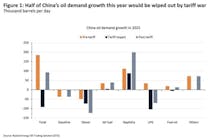MARKET WATCH: NYMEX crude oil prices hover above $52/bbl, Brent above $61/bbl
Crude oil prices fell by more than $1/bbl on New York and London markets Jan. 22 with light, sweet crude oil settling above $52/bbl as US markets reopened for trading after being closed on Jan. 21 for Martin Luther King Jr. Day.
Analysts noted that the US crude oil contract for March settled above $54/bbl on Jan. 18, a new short-term high. US crude futures have been volatile since reaching $76.90/bbl on Oct. 3, 2018.
Energy prices rallied for the week ended Jan. 18 with US crude futures prices gaining 3% and natural gas futures gaining 7% for the week.
Helge Andre Martinsen, DNB Bank senior oil analyst, said, “We remain positive on oil prices in 2019, primarily due to a much tighter fundamental oil market balance compared with second-half 2018, but we also see several other supporting factors for oil prices.”
DNB Bank forecast Brent oil for 2019 will average $70/bbl. Its economists foresee no signs of a significant weakening in oil demand growth.
Martinsen said DNB Bank forecast “a profound weakening of non-OPEC production growth in 2019. We expect a continued drop in the US rig count over the next few months, and fracturing crews in US shale oil are down 30% since the May 2018 peak.”
Other analysts said oil investors are optimistic US-China trade talks are making progress although commodity and equity markets are likely to remain volatile pending more US-China talks on Jan. 30-31.
Chinese Vice-Premier Liu He plans to visit Washington, DC, for trade negotiations. At the White House Jan. 19, US President Donald Trump told reporters that “things are going very well with China and with trade,” but denied reports US tariffs on Chinese products would be lifted, calling the reports false.
Oil prices were supported after the Organization of Petroleum Exporting Countries reported that its December oil output fell sharply, easing concerns about ample world oil supply.
OPEC said its December output fell by 751,000 b/d to 31.58 million b/d. OPEC members had started to cut oil production even before a production-cut agreement became effective Jan. 1. OPEC and some non-OPEC members agreed to cut production by a total of 1.2 million b/d.
Separately, US officials are expected to extend waivers to countries importing Iranian oil as the first round of US oil waivers expire in May. The waivers kept more Iranian oil on world markets than initially expected, building supply.
Energy prices
The February light, sweet crude contract on the New York Mercantile Exchange declined by $1.23 to settle at $52.57/bbl on Jan. 22 while the contract for March dropped $1.03 to settle at $53.01/bbl.
NYMEX natural gas for February fell 44¢ to close at $3.04/MMbtu on Jan. 22.
Ultralow-sulfur diesel for February declined by nearly 1.5¢ to a rounded $1.90/gal. The NYMEX reformulated gasoline blendstock for February fell 5¢ to $1.40/gal.
Brent crude for March declined $1.20 to $61.50/bbl on London’s Intercontinental Exchange while the April contract fell $1.21 to settle at $61.38/bbl. The gas oil contract for February dropped $9 to $565.25/tonne on Jan. 22.
The average price for OPEC’s basket of crudes was $60.66/bbl on Jan. 22, down 83¢.
Contact Paula Dittrick at [email protected].

Paula Dittrick | Senior Staff Writer
Paula Dittrick has covered oil and gas from Houston for more than 20 years. Starting in May 2007, she developed a health, safety, and environment beat for Oil & Gas Journal. Dittrick is familiar with the industry’s financial aspects. She also monitors issues associated with carbon sequestration and renewable energy.
Dittrick joined OGJ in February 2001. Previously, she worked for Dow Jones and United Press International. She began writing about oil and gas as UPI’s West Texas bureau chief during the 1980s. She earned a Bachelor’s of Science degree in journalism from the University of Nebraska in 1974.

